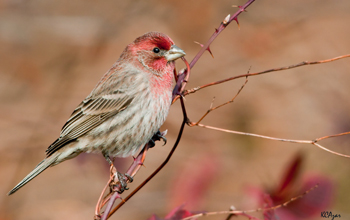Multimedia Gallery
Studying disease virulence in house finches (Image 6)
A healthy male house finch perches on a bramble in Pennsylvania. [Image 6 of 6 related images. Back to Image 1.]
More about this image
Researchers are studying house finch eye disease, a form of conjunctivitis, or pinkeye, that is caused by the bacteria Mycoplasma gallisepticum and has led to an estimated population decline of 40 million house finches in its first five years. House finches that contract the disease develop swollen, weepy eyes; become lethargic; suffer reduced vision; and may succumb to adverse weather or be caught by predators such as hawks and cats.
National Science Foundation (NSF)-supported researchers at Virginia Polytechnic Institute are studying the disease, in particular, why pathogens cause harm to the hosts they depend on and why are some life-threatening, while others only give you the sniffles? The research offers a model to help understand how diseases that threaten humans may change in virulence as they become more prevalent in a host population.
"This study is the first to confirm predictions that pathogens may evolve to become more deadly. The results are important for planning responses to events such as the bird flu outbreak in China," said Sam Scheiner, NSF program director for the joint NSF-National Institutes of Health Ecology and Evolution of Infectious Diseases Program, which funded the research.
André Dhondt, director of bird population studies at Cornell University, says "there's an expectation that a very virulent disease will become milder over time, to improve its ability to spread, otherwise, it just kills the host and that's the end of it for the organism." House finch eye disease has given researchers an opportunity to test this--and they were surprised to see it actually become worse rather than milder.
To learn more, see the NSF press release Evolution in the Blink of an Eye. (Date of Image: 2010)
Credit: Kelly Colgan Azar
See other images like this on your iPhone or iPad download NSF Science Zone on the Apple App Store.
Images and other media in the National Science Foundation Multimedia Gallery are available for use in print and electronic material by NSF employees, members of the media, university staff, teachers and the general public. All media in the gallery are intended for personal, educational and nonprofit/non-commercial use only.
Images credited to the National Science Foundation, a federal agency, are in the public domain. The images were created by employees of the United States Government as part of their official duties or prepared by contractors as "works for hire" for NSF. You may freely use NSF-credited images and, at your discretion, credit NSF with a "Courtesy: National Science Foundation" notation.
Additional information about general usage can be found in Conditions.
Also Available:
Download the high-resolution JPG version of the image. (692 KB)
Use your mouse to right-click (Mac users may need to Ctrl-click) the link above and choose the option that will save the file or target to your computer.



